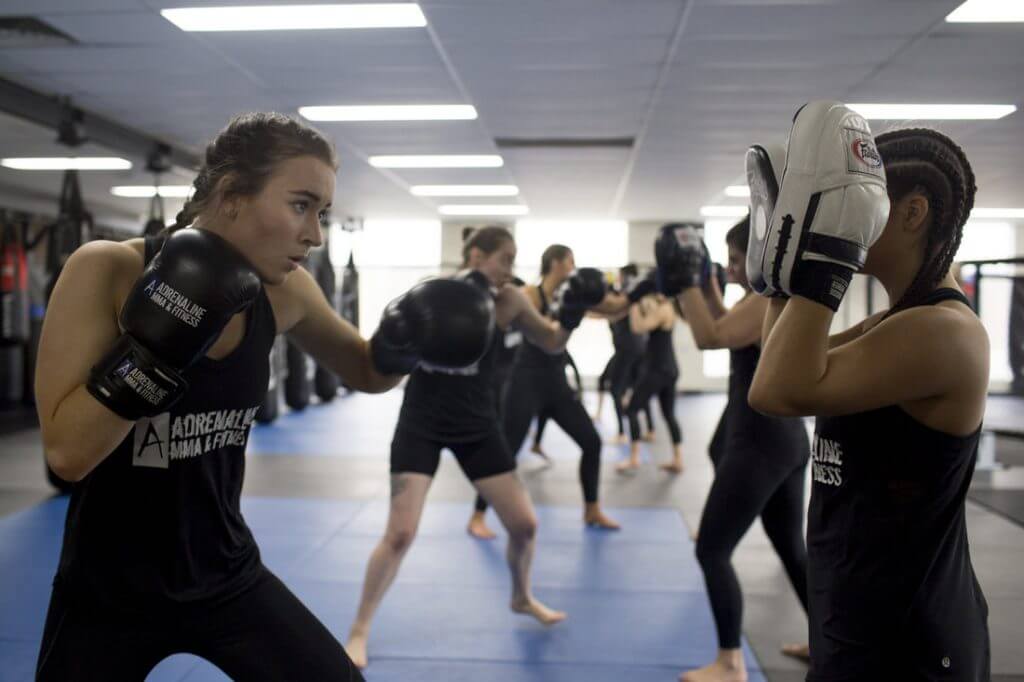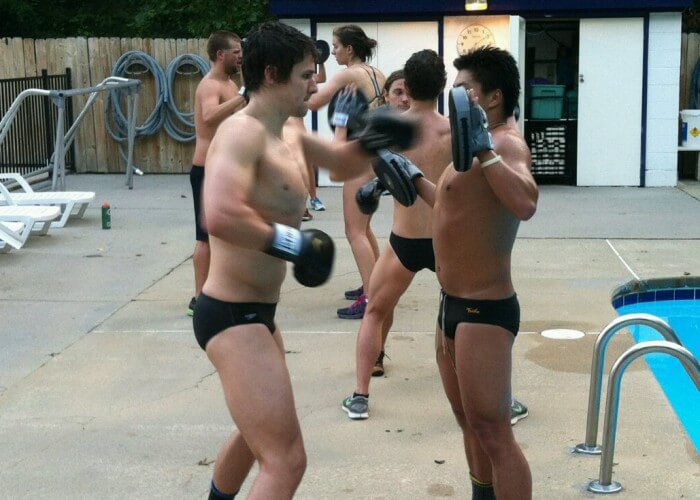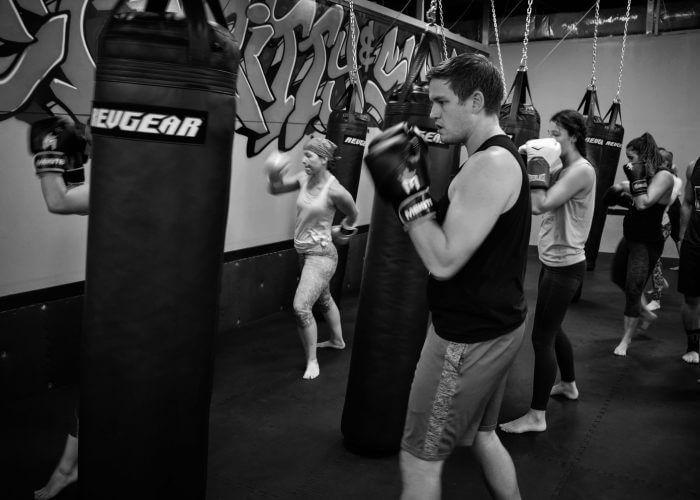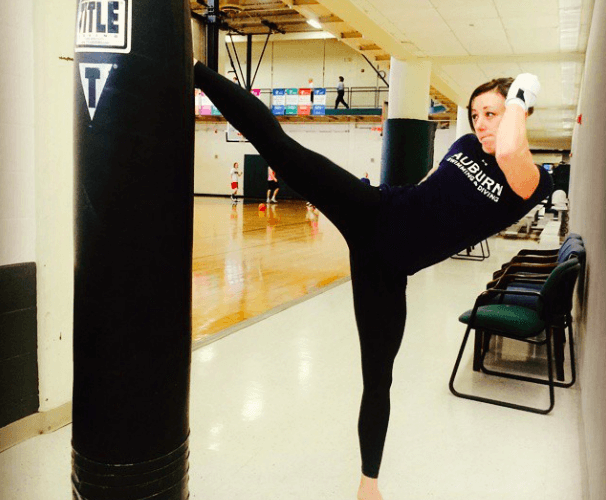Kickboxing: The Best Kept Training Secret for Swimmers

By Michaela Morrison
If you’re in between seasons or looking for an alternate dryland program, take a moment to consider adding kickboxing to your training regimen.
What is kickboxing?
At its core, kickboxing is a cardio sport with the intent of working your whole body. Sound familiar? There is an emphasis on power and agility, being able to exert your max amount of power coupled with speed for a defined length of time.
Kickboxing focuses on a type of training called High-Intensity Interval Training (HIIT), training comprised of short bursts of challenging combinations of kicks and punches and other agile movements. The two key points of kickboxing are the intensity at which you work and the length of time you are working.
For training to be considered HIIT, and for you to reap the benefits of this type of training, you’ll have to push yourself to your max every set.

Photo Courtesy: Josh Huger
How will kickboxing help my swimming?
It is important for swimmers to be strong, and most high-level swimmers incorporate some weightlifting program into their mix to gain more muscle. But what benefit does strength gives us swimmers if we are not able to use that strength efficiently in the water? Being able to complete a 400-pound deadlift doesn’t necessarily translate to speed in the water.
The important distinction between strength and power is what translates your strength (or muscle) into power, and ultimately into speed. Kurt Jackson, Ph.D., an associate professor of neurology and rehab science at the University of Dayton explains: “Pure strength is what a weightlifter uses, but producing power is about both force and speed.” So hey, we’ve hit the jackpot with kickboxing!
The Journal of Muscle, Ligaments, and Tendons published a research study in which researchers examined the effects of kickboxing training on the physical fitness of a group of 30 track athletes. The athletes were randomly assigned to either a kickboxing or a non-kickboxing group, each with 15 members. Each group trained for one hour a day, three times per week for a five-week experiment period.
The results of the kickboxing group showed an improvement in upper-body power, aerobic power, anaerobic fitness, flexibility, speed, and agility. That’s a lot of boxes to check off and a lot of overlap with abilities required in swimming.

Photo Courtesy: Grit Box Fitness
After kickboxing, the athletes improved by over a second in their 50-meter dash. If the selected athletes for the experiment keep up with their kickboxing training, think of how much their sprinting would improve. Imagine what that over-a-second-improvement could mean for your 50-meter swim sprint. A second (or more) is a lot to bargain with!
What can I expect at a kickboxing class?
Fortunately, most sports practices follow the same structure of a warmup, main workout, and a cool down. Kickboxing is no different. Classes differ depending on which gym you attend, but most start with a warmup focused on cardio drills and calisthenic-type exercises to help get your body moving. From there, you will put on your gloves and the instructor will guide you through two to three minute rounds for twenty to twenty-five minutes on a kickboxing bag.
There are periods of active rest between each set which can include any calisthenic activity from squat jumps to burpees. You are constantly moving your body, challenging it to adapt to new stimuli and increasing your cardio capacity all while maintaining your max amount of power.
During some rounds, the instructor will want you to solely focus on generating power, which requires the athlete to use slightly slower movements. Other rounds will be focused on speed, trying to generate that same power from before, only quicker.

Photo Courtesy: Lara Jackson
After the bags, your kickboxing instructor will call out different exercises for a ten-minute core workout. These ten-minutes may be the most painful ten minutes of your life, but your core is undoubtedly your best friend in swimming. If you have a strong core, you’ll be able to generate incredible amounts of power through your arms and legs. You’ll have those washboard abs in no time!
Just like in swimming, cooling down after the workout is crucial to helping your body recover. The last 10 minutes of the class is dedicated to stretching and helping your heart rate return to normal.
Tying it All Together
Remember: we are swimmers first and foremost. The training we do in the pool is the most important to see the best results in our races.
However, our minds and bodies have most likely grown accustomed to repetitive training over the years. Therefore, we are not allowing our bodies to be challenged in ways that encourage them to adapt and grow stronger.
Seeking out different training methods is a fun way to learn a new skill while supporting your swim training. So try something new this upcoming season – you’ll never unlock your full potential until you explore new options. Happy training!
All commentaries are the opinion of the author and do not necessarily reflect the views of Swimming World Magazine nor its staff.




Maddy Casswelll
Tara Tiernan. Kelly Tiernan this summer:)
Valentina Frank!
Vindicated!!
Andy Hasbún ?
See Momo you are ahead of the curve !!! Morgan Pierce!!!
Michelle?
Josh Barila
Abby Magee
Harold Rivera
Was at the top of my game in swimming. Injured my leg went into the cellar. My aunt trained in traditional Okinawan karate. Talk my father into letting me train. My body regained its strength and stamina had s good college career in swimming and water polo. That was in 1969.
How about TaekWonDo??
Ian Atticus Moore ?
Who would of thought
SJSU